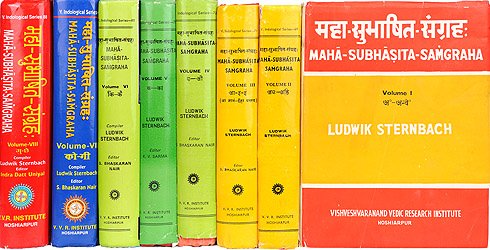Sanskrit quote nr. 6895 (Maha-subhashita-samgraha)
Sanskrit text:
उद्यानं वनभूमयः कुसुमितैरुद्गन्धयः पादपैः ।
शैला निर्झरहासिनो जलधरश्यामा गिरिः कृत्रिमः ॥udyānaṃ vanabhūmayaḥ kusumitairudgandhayaḥ pādapaiḥ |
śailā nirjharahāsino jaladharaśyāmā giriḥ kṛtrimaḥ ||
Index
Presented above is a Sanskrit aphorism, also known as a subhāṣita, which is at the very least, a literary piece of art. This page provides critical research material such as an anlaysis on the poetic meter used, an English translation, a glossary explaining technical terms, and a list of resources including print editions and digital links.
Glossary of Sanskrit terms
Note: Consider this as an approximate extraction of glossary words based on an experimental segmentation of the Sanskrit verse. Some could be superfluous while some might not be mentioned.
Udyana (udyāna, उद्यान): defined in 14 categories.
Vanabhumi (vanabhūmi, वनभूमि): defined in 1 categories.
Kusumita (कुसुमित): defined in 3 categories.
Udgandhi (उद्गन्धि): defined in 2 categories.
Padapa (pādapa, पादप): defined in 9 categories.
Shaila (saila, śaila, शैल, śailā, शैला): defined in 13 categories.
Nirjhara (निर्झर): defined in 7 categories.
Hasin (hāsin, हासिन्): defined in 3 categories.
Jaladhara (जलधर): defined in 7 categories.
Shyama (syama, śyāma, श्याम, śyāmā, श्यामा): defined in 18 categories.
Giri (गिरि): defined in 16 categories.
Kritrima (krtrima, kṛtrima, कृत्रिम): defined in 13 categories.
Defined according to the following glossaries/dictionaries: Sanskrit, Tibetan Buddhism (Vajrayana or tantric Buddhism), Vastushastra (architecture), Purana (epic history), Ayurveda (science of life), Jyotisha (astronomy and astrology), Shaktism (Shakta philosophy), Shaivism (Shaiva philosophy), Mahayana (major branch of Buddhism), India history, Marathi, Hindi, Kannada, Arts (wordly enjoyments), Pali, Chandas (prosody, study of Sanskrit metres), Jainism, Dharmashastra (religious law), Vaishnavism (Vaishava dharma), Ganitashastra (Mathematics and Algebra), Kavya (poetry), Nepali, Hinduism, Shilpashastra (iconography), Natyashastra (theatrics and dramaturgy), Biology (plants and animals), Theravada (major branch of Buddhism), Prakrit, Vyakarana (Sanskrit grammar), Rasashastra (chemistry and alchemy)
Analysis of Sanskrit grammar
Note: this is an experimental feature and only shows the first possible analysis of the Sanskrit verse. If the system was successful in segmenting the sentence, you will see of which words it is made up of, generally consisting of Nouns, Pronouns, Verbs, Participles and Indeclinables. Click on the link to show all possible derivations of the word.
- Line 1: “udyānaṃ vanabhūmayaḥ kusumitairudgandhayaḥ pādapaiḥ”
- udyānam -
-
udyāna (noun, neuter)[adverb], [nominative single], [accusative single]
- vanabhūmayaḥ -
-
vanabhūmi (noun, feminine)[nominative plural], [vocative plural]
- kusumitair -
-
kusumita (noun, masculine)[instrumental plural]kusumita (noun, neuter)[instrumental plural]
- udgandhayaḥ -
-
udgandhi (noun, masculine)[nominative plural], [vocative plural]udgandhi (noun, feminine)[nominative plural], [vocative plural]
- pādapaiḥ -
-
pādapa (noun, masculine)[instrumental plural]
- Line 2: “śailā nirjharahāsino jaladharaśyāmā giriḥ kṛtrimaḥ”
- śailā* -
-
śaila (noun, masculine)[nominative plural], [vocative plural]śailā (noun, feminine)[nominative plural], [vocative plural], [accusative plural]
- nirjhara -
-
nirjhara (noun, masculine)[compound], [vocative single]
- hāsino* -
-
hāsin (noun, masculine)[nominative plural], [vocative plural], [accusative plural], [ablative single], [genitive single]hāsin (noun, neuter)[ablative single], [genitive single]
- jaladhara -
-
jaladhara (noun, masculine)[compound], [vocative single]
- śyāmā* -
-
śyāma (noun, masculine)[nominative plural], [vocative plural]śyāmā (noun, feminine)[nominative plural], [vocative plural], [accusative plural]
- giriḥ -
-
giri (noun, feminine)[nominative single]giri (noun, masculine)[nominative single]
- kṛtrimaḥ -
-
kṛtrima (noun, masculine)[nominative single]
About the Mahāsubhāṣitasaṃgraha
This quote is included within the Mahāsubhāṣitasaṃgraha (महासुभाषितसंग्रह, maha-subhashita-samgraha / subhasita-sangraha), which is a compendium of Sanskrit aphorisms (subhāṣita), collected from various sources. Subhāṣita is a genre of Sanskrit literature, exposing the vast and rich cultural heritage of ancient India.
It has serial number 6895 and can be found on page . (read on archive.org)
Sanskrit is the oldest living language and bears testimony to the intellectual past of ancient India. Three major religions (Hinduism, Buddhism, Jainism) share this language, which is used for many of their holy books. Besides religious manuscripts, much of India’s ancient culture has been preserved in Sanskrit, covering topics such as Architecture, Music, Botany, Surgery, Ethics, Philosophy, Dance and much more.
 buy this book
buy this book